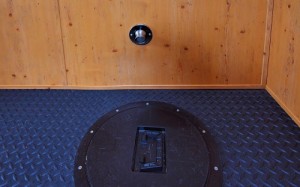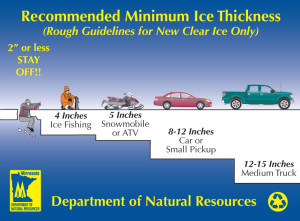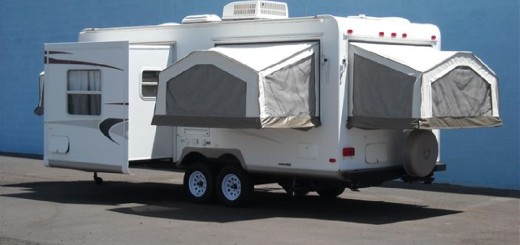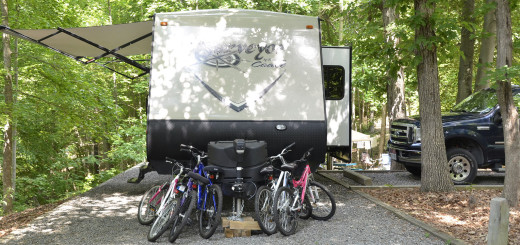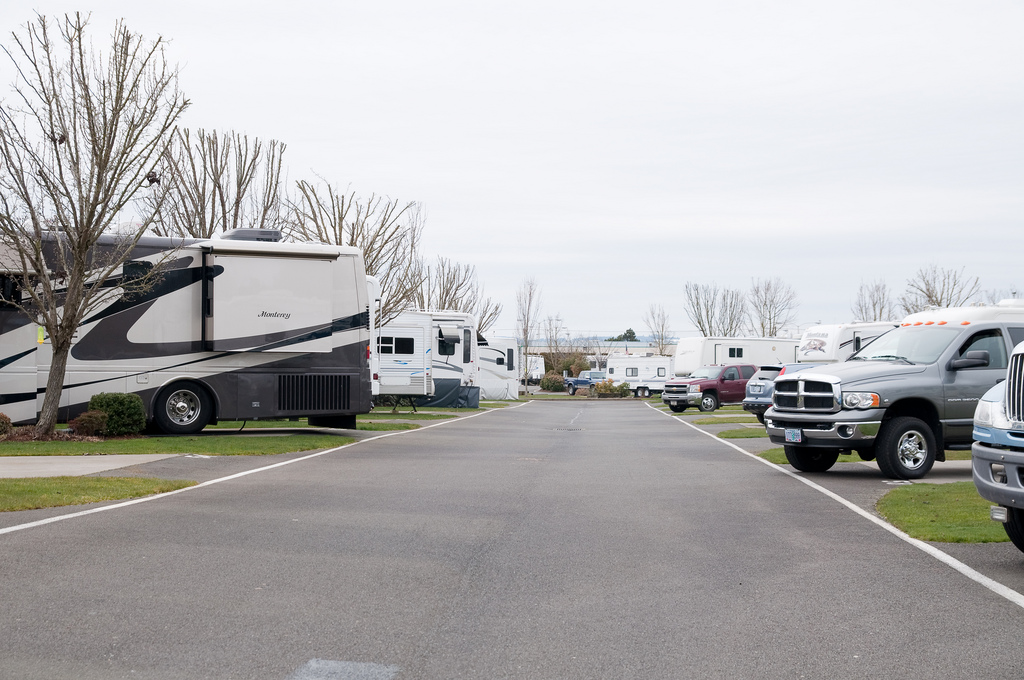Ice fishing is a popular winter pastime with deep roots. The sport has changed a lot in the last few decades, and grown in popularity too, but it has a history that extends well over 100 years into the past and involves an almost certainly apocryphal tale involving a mudslide, an outhouse, and a very creative man named Sven with some very peculiar ideas about what, exactly, constitutes a good fishing hole. In the early days of ice fishing, intrepid anglers had to make due with hastily constructed wooden shanties and canvas windbreaks, but innovation has come calling right along with the aforementioned changes the sport has undergone in recent years, and it’s now possible to fish from the relative comfort of a variety of portable fish houses. Of course, the newest, and possibly strangest, innovation in the field is actually a towable—a sort of portable ice fishing trailer that looks a whole lot like a travel trailer had a baby with an ice fishing shanty, because that’s precisely what happened.
From Shanties to Travel Trailers: Fishing in Style
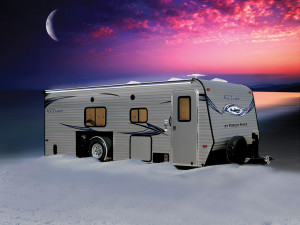
Forest River’s ice fishing trailers offer a home-away-from-home for winter anglers. Image courtesy of Forest River.
Although it’s possible to ice fish in a weather-tight dry suit and appropriately warm outerwear, the common trend over the last century and change has favored the “ice house,” which is a portable structure that can be hauled out on the ice once it’s safe and then hauled back before the ice thins, or, alternatively, packed in and out each time the angler goes fishing. These shelters range from small, wooden shanties, to foldable tent-like structures, to much larger mobile home-style affairs, but the basic idea is that the ice house provides shelter and warmth without impeding access to the ice.
Smaller shanties and pop-up shelters are designed for single use, while others can accommodate a few friends, and the largest shelters have long served as gathering spots or club houses of sorts out on the ice, where anglers can not only fish, but also warm up, have a drink, and even play cards. And from that came the new normal: ice fishing travel trailers.
Like other ice houses, the basic idea behind an ice fishing travel trailer is to provide a warm, dry, safe place to fish on the ice. To that end, ice fishing trailers are a lot like stripped-down travel trailers, built on similar platforms and providing similar amenities, including bathrooms, heating, and kitchen facilities. Unlike other shelters, they can be easily towed in and out and moved from place to place, and they essentially remove any need to leave the shelter until it is time to move.
How Do Ice Fishing Trailers Work?
Since ice fishing involves literally cutting a hole in lake or river ice and fishing through it, many ice fishing shelters omit any kind of floor, which provides direct access to the ice. Other shelters have relatively thin floors with plugged holes that can be used to access the ice, which is actually pretty similar to how ice fishing trailers work. The main issue is that travel trailers typically have a whole lot of ground clearance, which makes it possible to tow them without bottoming out, but isn’t exactly conducive to fishing on the ice.
In order to solve the ground clearance issue, ice fishing trailers actually have retractable wheels. When you arrive on the ice with one of these portable ice fishing shelters, you typically extend a set of power jacks, retract the wheels into alcoves cut in the body of the trailer, and then lower the rig down flush with the ice. The exact method and speed varies from one model to another, but the result is the same across the board, in that the trailer is lowered down to the point where you can remove a plug from the floor of the rig, cut a hole in the ice, and fish.
Ice fishing trailers typically come with a number of floor plugs, which provides a choice of where to fish from. And if the fish aren’t biting, you can just hitch the trailer back up and move it to a better spot.
All the Comforts of Home
Unlike other portable shelters, ice fishing trailers have the benefit of essentially being a specialty form of travel trailer. In fact, the only differences between an ice fishing travel trailer and a regular travel trailer are the retractable wheels, the floor plugs, and the decor. Since the intention behind an ice fishing trailer is to catch fish, most of these units have relatively utilitarian decorating touches, including a notable lack of carpeting and upholstery, which renders them much easier to clean than they would be otherwise.
Beyond that, ice fishing trailers often come with built-in entertainment systems, including radios, CD players, televisions, and even generators to power everything when you’re out on the ice. You typically also have a propane heater to keep the temperature at a comfortable level, a fridge and stove to store and cook your catch, toilet and shower facilities so you don’t have to go shivering across the ice in the middle of the night, and often enough sleeping space for six or more people.
Are Ice Fishing Trailers Safe?
The general rule of thumb for ice fishing is that you’re only safe until you’re not. Ice fishing is typically pretty safe when you take the necessary precautions, but the fact is that things can go wrong any time you’re out on a river or lake with nothing between you and the icy depths but a thin sheet of ice. Regardless of what you’re using for an ice fishing shelter, you always want to know how thick the ice is, and it’s vital to remember that ice thickness can vary a great deal within a relatively small amount of space due to a number of different causes. This is important when you hike out on foot, but it’s even more important if you’re driving your expensive truck and possibly even more expensive ice fishing trailer out there.
According to the Minnesota Department of Natural Resources, clear ice has to be 12-15″ thick before you can drive a medium duty truck on it, and white ice is significantly weaker:
Ice Thickness Guidelines
| Unsafe | Angler | Snowmobile | Passenger Car | Medium Duty Pickup | |
|---|---|---|---|---|---|
| New clear ice | > 2" | 4"+ | 5"+ | 8-12" | 12-15" |
| White snow ice | > 4" | 8"+ | 10"+ | 16-24" | 24-30" |
If you drive a larger truck, which may well be the case if you’re towing a heavy trailer, then you’re looking for even thicker ice to hedge against falling through. However, the weight of an ice fishing trailer will typically be less than your truck, so if it’s safe to drive your truck out on the ice, it will usually also be safe to park your trailer there. For instance, the GVWR of a 2015 F-250 is 10,000 lbs, while the GVWR of a 24’6″ Forest River Salem Ice House is 5,772 lbs.
Getting Off the Ice Safely
The apocryphal story of Sven mentioned earlier is also a cautionary tale for the would-be ice anglers of today. In that story, Sven’s neighbors all removed their fishing shelters as the ice began to thaw, while Sven continued to fish until his fell through the ice and was lost to time. It probably goes without saying, but you definitely don’t want that to happen to your fancy ice fishing trailer, your pickup truck, or yourself.
Part of getting safely off the ice, with the bounty you have pried from the cold depths of the lake, is being aware of prevailing ice conditions. You can check with local fishing resorts, bait shops and authorities before heading out on the ice to get a good idea of what’s happening out there, but you’ll also want to check for yourself. Some ice skimmers have built-in measuring devices, but you can also use any tape measure. You’ll also want to take your own measurements anyway, since ice thickness can vary a great deal over relatively short distances. In fact, the Minnesota DNR recommends checking every 150 feet.
Another useful tip is to cut a hole near your vehicle and monitor it. If water begins to flow over the top of the hole, that’s a sign that the ice in the area is beginning to sink due to the weight. When that happens, it’s time to move before you get wet. You can keep an eye on the holes you cut through the floor of your ice fishing trailer while you’re fishing, too, but when you’re out fishing on the ice, you’re always going to be better off safe than sorry.
Ice Fishing Trailer Manufacturers
In recent years, a number of RV manufacturers have jumped into the ice fishing trailer business, including:

